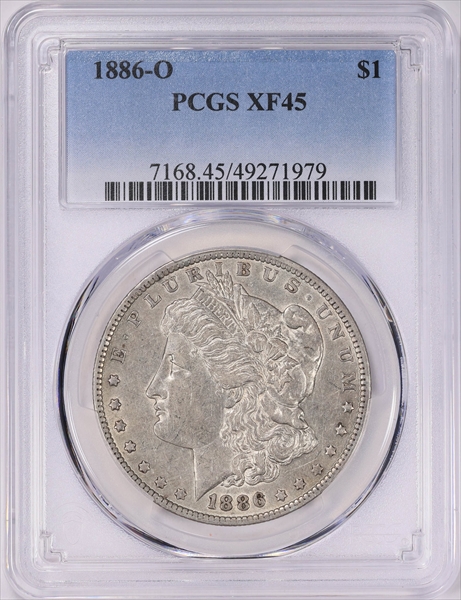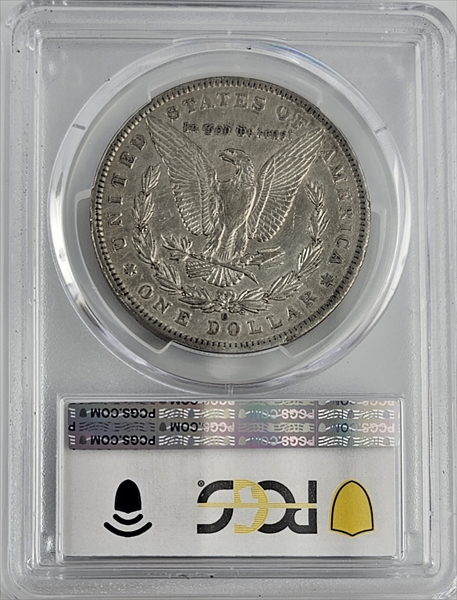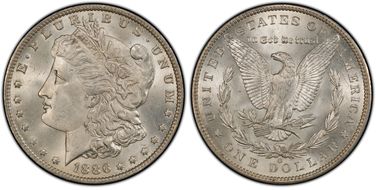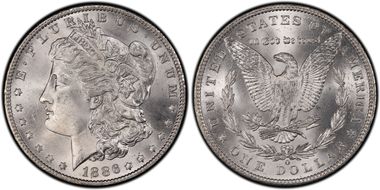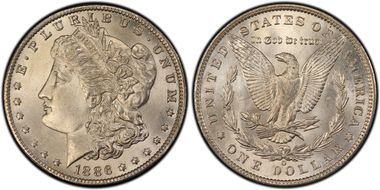1886-O $1 XF45 认证号49271979, PCGS号7168
专家评论
Q. David Bowers
The following narrative, with minor editing, is from my "Silver Dollars & Trade Dollars of the United States: A Complete Encyclopedia" (Wolfeboro, NH: Bowers and Merena Galleries, Inc., 1993)Coinage Context
Exclusivity: In 1886 the New Orleans Mint struck silver dollars exclusively. Even though the coiners had single-mindedness of purpose, they did a sloppy job, spaced the dies too far apart, and turned out millions of poorly struck coins. Of course, they did not have much pride in what they did, for the New Orleans Mint was unloved by the Mint bureau head-quarters folks in Washington, and, in any event, most recent production efforts involving silver dollars at New Orleans saw coins going from press to bag to storage; there was not much satisfaction in that seemingly unappreciated, futile effort.
Numismatic Information
An anomaly: Among Morgan dollars, the 1886-O is somewhat of an anomaly. The mintage figure of 10,710,000 circulation strikes is overwhelming and even puts in the shade such common coins as the 1883-O, 1884-O, and 1885-O. By all rights, like these other coins, a million or more 1886-O dollars should have come to light in the great Treasury release of 1962-1964, and today a beautiful MS-65 1886-O should be in every collection.
Not so. It didn't happen. What did happen isn't known, at least not with certainty. At or near the time of striking in the nineteenth century, probably a few million coins, say two to four million, were placed into circulation and saw commercial use. Probably, millions of other coins, perhaps as many as six to eight million pieces, went to the melting pot under the terms of the 1918 Pittman Act. Whatever happened, apparently no more than a few bags dribbled onto the market in the 1940s and 1950s-enough to keep the issue in the $6 to $10 range for most of the period 1945-1960. I recall that few dealers wanted to stock 1886-O dollars, for Uncirculated pieces were usually ugly and, technically, were probably on the order of what would be called MS-60 or MS-61 today. In the Treasury release of 1962-1964 probably a few bags came out, but I have obtained no specific record of them. The issue was regarded as slightly on the scarce side in the 1960s, and Harry J. Forman's price of $375 per roll ($18.75 per coin) in May 1965 was an offer that few others could match, for few had quantities to offer. Harry recalled that he never had an intact bag of 1886-O dollars, but he did find several hundred "minimum Uncirculated" coins in a bag containing various dates.
Despite its prodigious mintage, the 1886-O is a rarity today in the 1990s, in MS-65 grade, while its contemporaries, the 1883-O, 1884-O, and 1885-O, are very common.
Circulated grades: In worn grades the 1886-O is not hard to find, although it is not among the commonest issues. I estimate that 175,000 to 350,000 remain.
Mint State grades: Mint State coins are scarce. Most seen are in lower levels such as MS-60 and MS- 61, or MS-62. In these ranges perhaps 5,000 to 10,000 exist. Correctly graded MS-63 coins are scarce on the current market. I say current market, for as noted, years ago the 1886-O was not recognized as being hard to find. In MS-64 grade it is extremely difficult to locate; probably somewhere between 125 and 250 remain. In MS-65 preservation the 1886-O is the rarest New Orleans Mint Morgan dollar; at least one exists, but possibly no more than three. Most 1886-O dollars in various degrees of Mint State are weakly struck.
Apparently, high-grade Mint State coins were not always considered to be rare, and in 1982 Wayne Miller, who had recently purchased 80 fully-struck Uncirculated coins, called the issue "the most over-rated of the rare date Uncirculated Morgans," further noting that the "enthusiasm for this date has approached hysteria in recent years."
The market changes, and yesterday's abundance sometimes turns to today's scarcity, as coins are placed into collections for the long term. I have learned never to underestimate the ability of the American public to put things away. In the 1970s I wondered where all of the untold millions of Franklin Mint medals, collector plates sold by the Bradford Exchange and others, and Jim Beam bottles were going, but wherever they went, most have stayed off the market. So it is with silver dollars. Time and again in my own business I have dispersed small hoards of this rare coin or that one, thinking at the time that these pieces would soon come back to me for sale at auction or for purchase. But, by and large, most coins seem to disappear. Be that as it may, and notwithstanding the dozens of sharply struck pieces mentioned by Wayne Miller, I recall that years ago, as today, most Uncirculated 1886-O dollars were of very low aesthetic appeal.
Prooflike coins: Semi-prooflike coins are scarce, and fully prooflike coins are rare. Most prooflike coins have extensive bagmarks and are in lower grades. The finest known DMPL is probably the one slabbed by NGC as MS-67, which amazed onlookers as it sold for $231,000 in the Chris Schenkel sale (Bowers and Merena, November 1990). This coin was pictured in Wayne Miller's book and had the signal honor of being described by him as being "universally considered to be the most spectacular Morgan dollar now known, considering the extreme rarity of the date in gem prooflike condition." Probably no more than two or three MS-65 or better DMPL coins exist, including the previously mentioned MS-67.
Die rotation: Examples of VAM4 are known with the reverse die rotated 15° to 48° clockwise from the normal alignment. Specimens of VAM-II exist with the reverse rotated 33° to 45° counterclockwise from the normal orientation. Both V AM varieties are scarce with such rotational misalignments. Van Allen and Mallis note that these varieties are not available above AU grade.
Caveat emptor: Beware of high-grade 1886 Philadelphia Mint coins with an 0 mintmark added to make a spurious "1886-O." These forgeries are not common, but they must be mentioned. Look for a seam where the O meets the field.
The entire area of high-grade 1886-O dollars is terra incognita to many dealers, especially those who have come into the market in the past decade or so. Before spending a lot of money, it may well pay you to seek some professional advice, even if you have to pay for it (which you probably won't have to do).
Varieties
Circulation strikes:
1. Normal date: Even 6, Breen-5589; high 6, Breen-5590, VAM-2. Both varieties are usually found in low grades. At least six VAM varieties have partly repunched dates; another (VAM-7) has repunched mintmark. The key variety is VAM-IA with E on reverse, due to a clashed die; Jeff Oxman reported that this exists in two stages, the first showing what seems to be double clashing, and the second what seems to be seven clashes!' Probably 40 or more pairs of dies were utilized, which may indicate that with the aid of a low-power microscope specialists have the potential of vastly enlarging the list of 15 VAM varieties now known. On the other hand, as millions of 1886-o dollars were melted, these destruction activities may have included the production of certain die pairs in toto.
Dies prepared. Obverse: 40+; Reverse: 40+
Circulation strike mintage: 10,710,000; Delivery figures by month: January: 900,000; February: 900,000; March: 900,000; April: 900,000; May: 900,000; June: 900,000; July: 600,000; August: 900,000; September: 910,000; October: 900,000; November: 1,000,000; December: 1,000,000.
Estimated quantity melted: Probably 6,000,000 to 8,000,000 were melted, probably under terms of the 1918 Pittman Act.
Availability of prooflike coins: Prooflike coins are very rare, and those that are seen are apt to be in lower grades, poorly struck, and with many bagmarks. However, a few sharply struck cameo DMPL coins in higher grades are known, the fin-est of which is MS-67 DMPL.
Characteristics of striking: Usually weakly struck Known hoards of Mint State coins: None of significance existing today.
Commentary
Despite a high mintage, the 1886-O ranges from common and cheap in low grades to unexpectedly rare and expensive in high grades. Gems are practically unobtainable.
PCGS #
7168
设计师
George T. Morgan
边缘
Reeded
直径
38.10 毫米
重量
26.73 克
铸币数量
10710000
金属成分
90% Silver, 10% Copper
更高评级数量
8006
评级较低的钱币数量
860
地区
The United States of America
价格指南
PCGS 数量报告
拍卖 - PCGS 评级的
拍卖 - NGC 评级的
稀有性和存量估计 了解更多
| 所有评级 | 1000000 |
| 60或以上 | 19000 |
| 65或以上 | 3 |
| 所有评级 | R-1.1 |
| 60或以上 | R-2.8 |
| 65或以上 | R-9.8 |
| 所有评级 | 87 / 117 TIE |
| 60或以上 | 31 / 117 TIE |
| 65或以上 | 1 / 117 |
| 所有评级 | 87 / 117 TIE |
| 60或以上 | 31 / 117 TIE |
| 65或以上 | 1 / 117 |




















